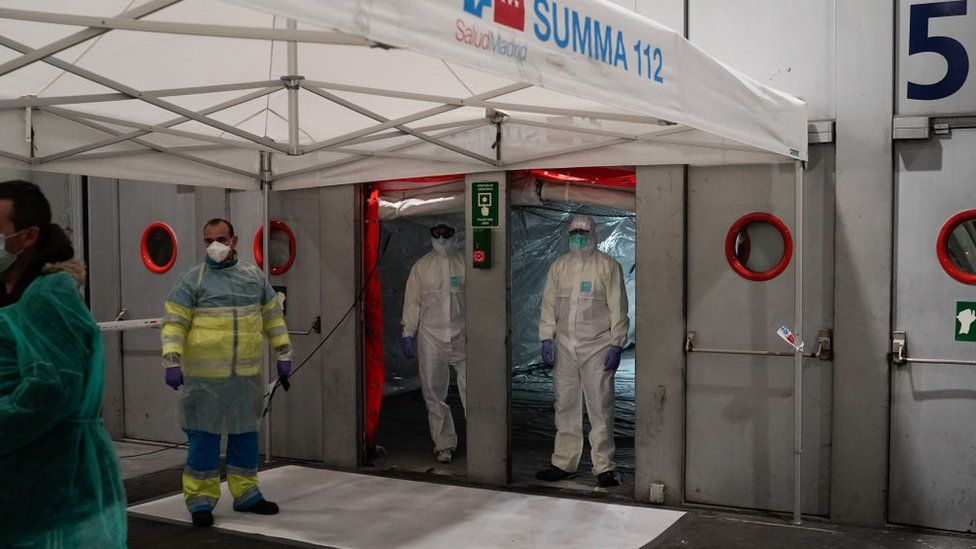Coronavirus: Spain's coronavirus outbreak 'slowing'
- Published

A temporary hospital in the Ifema exhibition centre in Madrid opened to patients last week
The growth in coronavirus cases in hard-hit Spain appears to be slowing, the country's foreign minister has told the BBC.
Another 6,400 cases were confirmed on Monday, the lowest increase in new cases for a week. The total of deaths reached 7,340 after 812 new fatalities.
It comes as a national lockdown expanded to instruct non-essential workers to stay home for two weeks.
Globally, 36,211 people have died, with 755,591 testing positive.
Meanwhile, the doctor leading Spain's response to the outbreak has tested positive.
What's the latest in Spain?
Spain's latest national figures show that the virus' upwards curve appears to be flattening out, Foreign Minister Arancha González says.
Officials are hoping that the peak of the virus outbreak there is approaching, after which new cases and deaths are expected to decrease.
Catalonia, the Basque region and capital Madrid remain some of hardest-hit areas.
A near total lockdown to contain the virus has been in place since 14 March, with residents only allowed to leave their homes for work, essential food and medicine purchases, or to care for relatives.
Health official Maria Jose Sierra said that following the introduction of restrictions, the trend in daily infections had changed. New cases are rising at about 12% a day, compared with 20% before 25 March.
Coronavirus: Lessons for lockdown from an Italian family
A stricter ban on all "non-essential" activities is now in place until 9 April.
The foreign minister also told the BBC that pressure on intensive care units continues to be Spain's biggest challenge, and that new restrictions being imposed today will help to contain the spread.
Ms González said it was unfair to single out Spain because many other countries - including Italy and the US - were also dealing with unprecedented numbers.
A minute's silence on Monday in Madrid remembered the country's 7,340 coronavirus victims
Dr Fernando Simon, who leads the country's response to the coronavirus epidemic and maintains regular contact with Prime Minister Pedro Sánchez, has tested positive for the virus, Ms Sierra told a press conference..
On Monday a minute's silence was held in Madrid at midday to remember those who have died from the virus. The country is the country with the highest number of deaths in the world behind Italy.
A SIMPLE GUIDE: How do I protect myself?
AVOIDING CONTACT: The rules on self-isolation and exercise
MAPS AND CHARTS: Visual guide to the outbreak
VIDEO: The 20-second hand wash
What's the situation in the rest of Europe?
Germany has so far avoided a deadly outbreak on the scale of Spain and Italy, but it did report a jump in cases on Monday of 4,751, bringing the total to 57,000.
It has reported only 541 deaths - this comparatively low number is being put down to widespread testing that records cases with mild symptoms, unlike many countries.
The German healthcare system is also highly extensive, meaning it can cope relatively well with a high number of seriously ill patients.
More French patients were airlifted from Strasbourg to German hospitals by helicopter on Monday.
Moscow began a lockdown of its 12 million residents as the Russian government moves to curb an outbreak.
In Austria, shoppers will now be required to wear masks inside stores, authorities announced on Monday.
And in Hungary, the parliament will vote on whether to give Prime Minister Viktor Orban sweeping new powers to tackle the outbreak - critics say they could curtail freedom of speech.
What's happening in the rest of the world?
The US has emerged as the new epicentre of the virus, with 153,246 confirmed cases - about 52,000 more than the second-worst-hit country, Italy.
Lockdowns are coming into force this week in a number of countries and cities, including in Nigeria and Kenya, while existing measures in countries including India and South Africa continue.
But as most of the world tightens its restrictions on movement in order to try and contain the virus, people in China are seeing the light at the end of the tunnel.
Public inter-city transport in Hubei, where the virus first emerged in December, has started to resume, and life in the city has begun to return to normal.
- Published30 March 2020
- Published30 March 2020
- Published30 March 2020